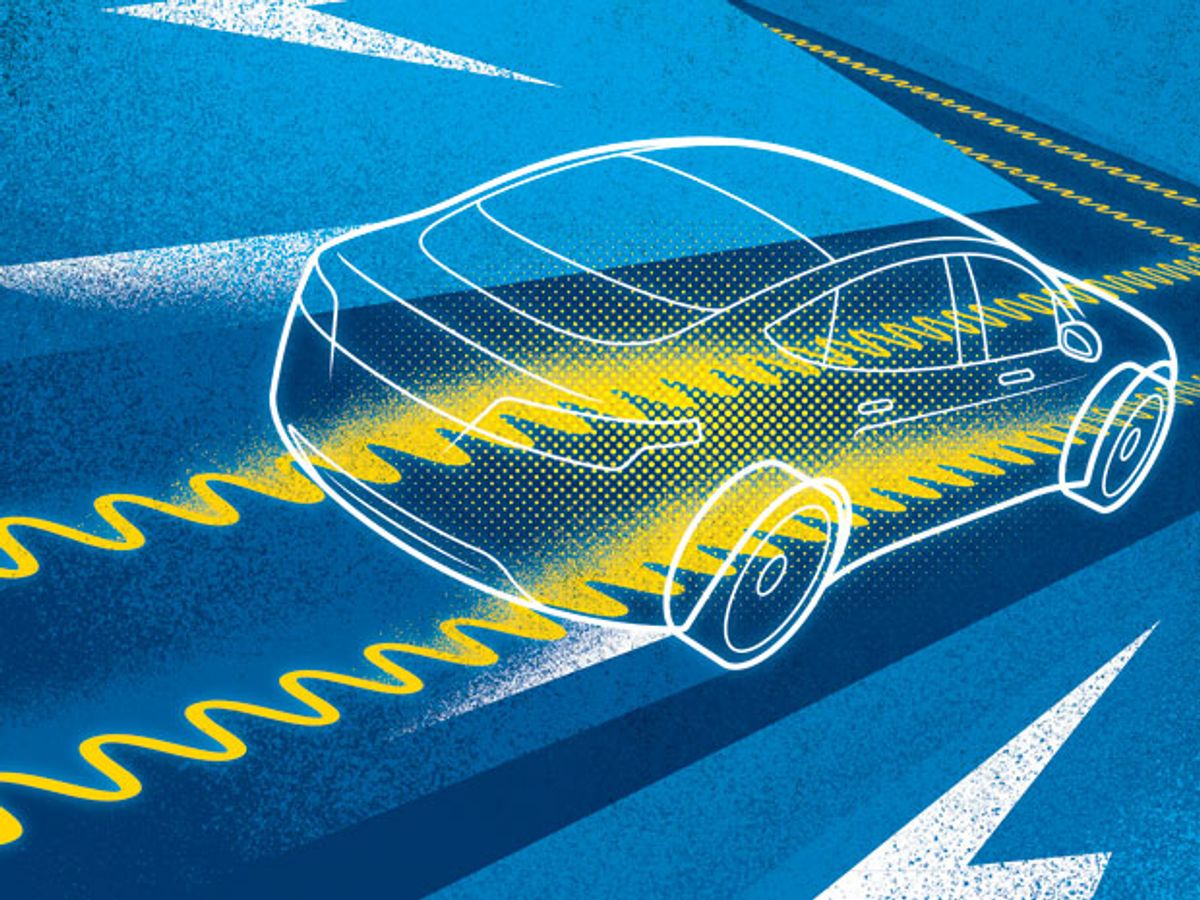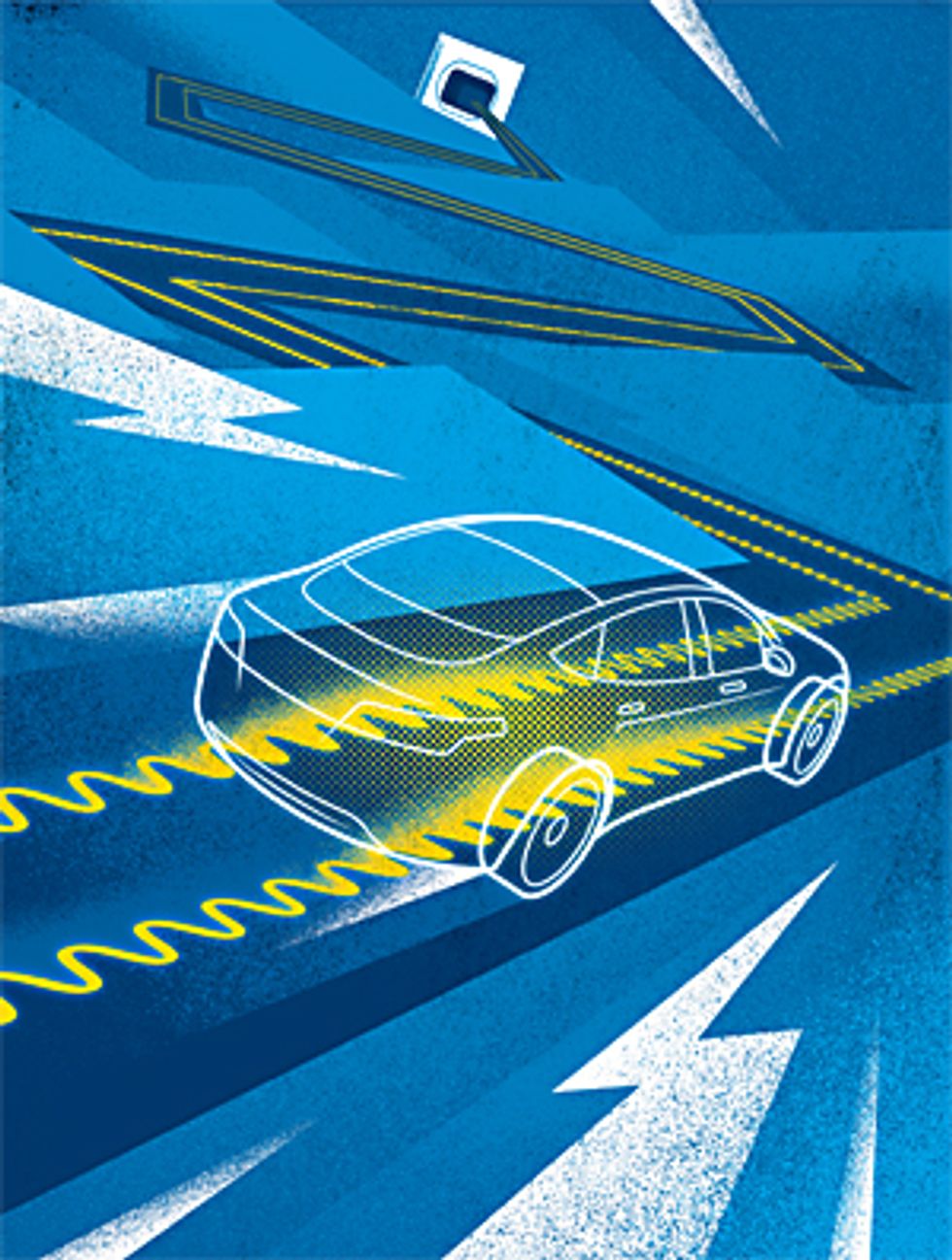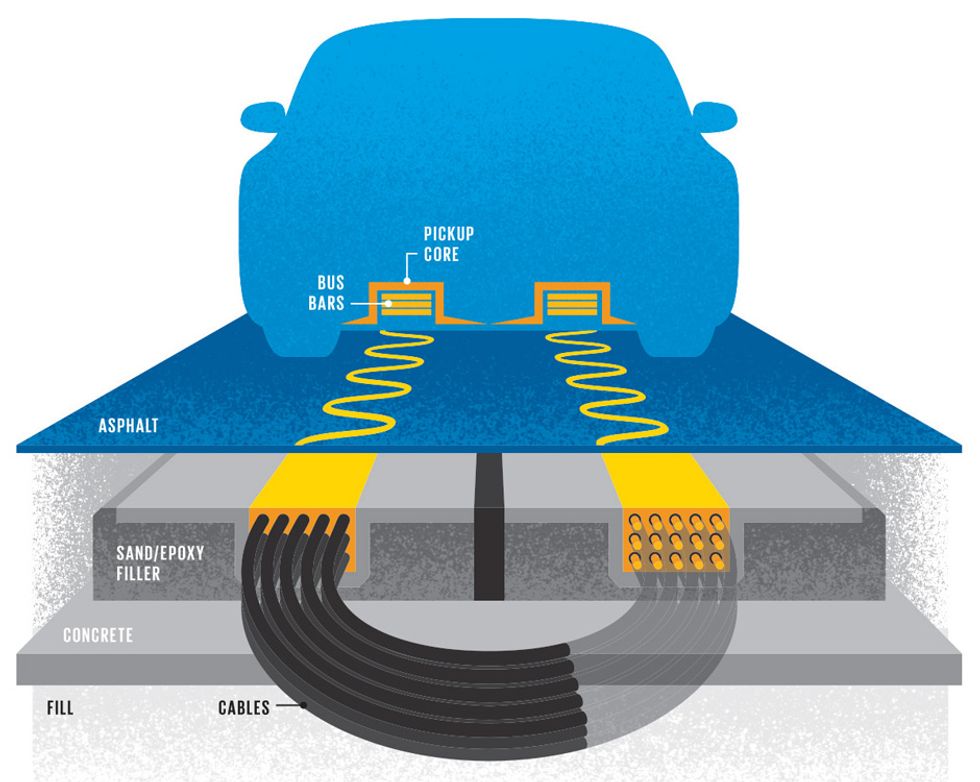The All-Electric Car You Never Plug In
Wireless power transmission would let EVs draw their power from the road


Picture an all-electric vehicle cruising down the highway, emitting little noise and no noxious fumes. It’s such an improvement that you have to wonder why only a handful of all-electric vehicles are now available on the mass market.
Here’s a big reason: Picture the driver of that same car getting a call from a relative living far away who needs immediate help. Suddenly, the driver’s eyes become riveted on the most important indicator on the dashboard: the estimated number of kilometers that the car can go on the remaining battery charge. Will he make it to his relative’s house? Even if he does, will he find a charging station so he can get back home?
There’s a name for this modern misgiving: range anxiety, a new form of disquiet experienced by drivers of all-electric cars. The Nissan Leaf, for example, can be driven on the highway for only about 120 kilometers on a single charge, and fully charging up its batteries takes 8 hours or more.
But maybe there’s a way to relieve this fear forever and make drivers’ lives much easier as well. If we embed transmitting coils in roadways, electric cars carrying receiving coils could charge themselves as they zoom down the road. An e-car owner would never have to search for a charging station or plug in the car. That is the goal of our research team at the Korea Advanced Institute of Science and Technology (KAIST), in Daejeon, which has developed what we call the on-line electric vehicle (OLEV) system.
Wireless power transmission isn’t a new idea: Nikola Tesla built a 57-meter-tall tower behind his lab in Shoreham, N.Y., in the first years of the 20th century, partly to beam power to remote equipment. But only in the past decade have researchers begun to make the breakthroughs that can allow for commercially practical wireless charging, not only for portable electronic products like smartphones but even for industrial robots and electric cars.
The technology depends on the same principle of electromagnetic induction that enables a transformer to change the voltage of an alternating current. This current flows through one coil of wire, creating a magnetic field whose polarity reverses with each cycle and inducing a corresponding alternating field in a secondary coil. The ratio of the number of turns in the two coils determines whether the transformer steps voltage up or down. Transformers usually include an iron-rich core, which links the coils and increases the field strength, but you don’t really need it. If the two coils are separated by air, current flowing through the first coil will still create a magnetic field, which will still be picked up by the second coil—it just won’t be picked up as well. The greater the air gap, the less efficient the transfer of power will be.
More than 90 years after Tesla began building his tower, an ambitious project in California tried to apply his concept of wireless power transmission to automobiles. In 1994, the Partners for Advanced Transit and Highways project, led by researchers at the University of California, Berkeley, demonstrated the transfer of power from coils buried in the road to the cars above. It worked whether the cars were at rest or in motion. The receiving coils were on the underside of the test vehicles and were separated from the transmitting coils by an air gap of only 7.5 centimeters. They captured 65 percent of the injected power, an impressive achievement at the time. But still, a scheme that wasted a full 35 percent of the power could not be brought to market, and an air gap that narrow would have required hanging the receiving coils so low that a bump or a pothole could have sheared them right off.
How, then, to increase the efficiency of the power transfer without having to make the low-slung receivers even more vulnerable? The answer that we and other researchers have recently settled on is called magnetic resonance coupling.
A familiar illustration of the power of resonance is that of the opera singer and the wine glass. As the diva warbles, the acoustic waves hit the glass, causing it to vibrate; if she hits the note with the same natural frequency as the glass, each cycle will amplify the vibrations until finally they are strong enough to shatter the glass. The singer’s voice enters into a special relationship with that glass, passing more energy to it than to other, nonresonating items in the room. Similarly, when a transmitting coil sends electromagnetic waves tuned to a frequency matching the resonance of a circuit holding a receiving coil, it will transfer energy to it very efficiently.
Researchers around the world have begun applying this principle over the past decade. In 2007, MIT professors caught the world’s attention by powering a lightbulb suspended in space, 2 meters away from the transmitting coil. Those researchers went on to found a Massachusetts start-up, WiTricity Corp., which is working with several auto companies on wireless charging stations for household garages. Quebec’s Bombardier is developing its Primove system in Europe to transmit power to public buses and trams.
Our research at KAIST began in 2009 when one of us (Suh) identified battery-powered electric cars as a technology that would work far better if these cars didn’t have to lug around such huge, expensive batteries. Suh met with Myung-bak Lee, then the president of South Korea, and proposed that KAIST develop wirelessly powered vehicles. The National Science and Technology Council allotted the enterprise US $25 million, and our OLEV project was ready to roll.
On a cool March day in 2010, a distinguished group of scientists and politicians gathered in Seoul Grand Park to witness the inaugural run of a bright green-and-blue tram wreathed in flowers, with the words “Seoul Zoo” painted on its nose. Se-hoon Oh, then the mayor of Seoul, declared that he expected wirelessly powered buses and trams to be “the environment-friendly transportation in the future.”
Today the OLEV tram is still zipping around the park on a 2.2-km loop of roadway, 370 meters of which has transmitting coils embedded in the asphalt. As the tram rolls along, magnetic sensors in the road detect its approach and activate the transmitters to send 62 kilowatts to the receiving coils on the underside of the tram. Meanwhile, the tram operator keeps an eye on a monitor that shows how well the tram is aligned with the transmitting coils it passes over, and thus how efficiently it’s receiving power. (We are developing a system that will align the vehicle automatically by measuring the strength of the magnetic field.) The bus still contains a battery, but it carries 40 percent less energy than it would have to otherwise. It’s also 6 percent lighter, at 1100 kilograms, and significantly cheaper, costing $88 500.
The key advances our team made are in the design of the electromagnetic field. The first decision had to do with the relative strength of the two component fields—electric and magnetic. An engineer can choose which field to favor. For example, a dipole antenna generates a stronger electric field, and a loop antenna generates a more powerful magnetic field. We chose a dual loop design for the buried transmitter because magnetic fields are better at transmitting power through asphalt, dirt, and other substances that may come between the transmitter and the receiver.
The second decision was to increase the efficiency of this power transmission with a shaped magnetic field—one whose path from the transmitter coil to the receiver coil is guided by the presence of ferrite cores on both sides. This arrangement minimizes field leakage and hence waste. In recent experiments with an OLEV bus, we charged the bus while it was being driven, its body 20 cm above the road, and achieved an average transfer efficiency of 75 percent.
Whereas experimental wireless charging stations for household garages can now transfer a measly 3.3 or 6.6 kW, the OLEV bus received 100 kW of power while in motion. You need such high power to propel heavy buses full of people and to reduce charging time. By embedding the transmission coils at points where vehicles stop and linger, like parking garages, bus stops, taxi stands, and traffic lights, we plan to charge the vehicles more efficiently and also reduce investments in construction. After all, if vehicles spend a lot of time standing in place, why not put the chargers in those places?
We also took great care in selecting the resonance frequency for our OLEV system. As you raise the frequency through the kilohertz range, you induce proportionally higher voltage in the receiving coils and gain better transfer efficiency. As the frequency rises above the megahertz range, however, the cables for the transmitting and receiving coils suffer from what’s called skin effect: Current flows in an ever-thinner surface layer whose depth is inversely proportional to the square root of the frequency.
In an aluminum cable, the skin depth at 100 kHz is 0.25 millimeters, which you can deal with just by using suitably fine strands of wire. But at 10 megahertz, it comes to just 0.024 mm, which is tougher to deal with. Also, as the frequency mounts from the kilohertz to the megahertz range, our inverter’s switching device—an insulated-gate bipolar transistor—becomes dramatically less efficient at turning DC power into AC.
We used 20 kHz as the operating frequency in an OLEV bus demonstrated at Expo 2012, in Yeosu, South Korea. By July, we expect to have the world’s first commercial trial of such a bus up and running, in Gumi, South Korea.
In the next phase of the project, we’ll apply the OLEV technology to a high-speed railway system and make it even speedier. Today’s system limits the train speed to less than 300 kilometers per hour, because it picks up power from the cable by means of a spring-like metal link. Wireless transmission can free the train of this encumbrance, allowing it to reach faster speeds and negotiate narrower tunnels. In February, we demonstrated in the lab a 180-kW system for wireless power transfer that runs at 60 kHz (an operating frequency we have recently been able to achieve by redesigning the inverter). We expect to integrate this system into a railway vehicle by the end of the year.
Another interesting application of OLEV technology we are investigating is in ports, for the small vehicles used to move shipping containers. The limited field of required movement in that setting should make it particularly easy to embed power transmitters in the ground.
Our wireless scheme still faces many challenges, above all the possibility that the electromagnetic fields it generates might be a threat to people’s health. In Korea, as in most countries, the safety limit for magnetic field exposure has been set at 6.25 microteslas. The United States sets a much more lenient 205 μT, for the frequency range between 3.35 kHz and 5 megahertz.
It is a simple matter to stay below even the Korean limit inside a typical car, bus, or train whose structure is largely metallic. The metal body of our OLEV bus provided enough passive shielding to keep the magnetic field under 2 μT in all positions. Just to be sure, we also developed a complementary system that could hew to the 6.25-μT standard under all conditions—active shielding, which involves surrounding the passenger compartment with current-carrying wires that generate magnetic flux opposite to that of the external field.
Then there are the technical constraints: To match the 85 km/h maximum speed of a gasoline- or diesel-powered city bus requires a power transfer of 100 kW. That’s all the bus can use; most of the time it will consume less and divert the rest to the batteries. To match its total, inclusive energy efficiency—calculated on an “oil-well-to-bus-wheel” basis—the transmitting and receiving coils must be large enough to make use of at least 80 percent of the 100 kW while maintaining a gap of at least 20 cm between the road and the bottom of the bus.
Efficiency is always important, but it can be critical in high-power applications like railways and seaports because power losses translate into waste heat, which can be difficult to remove. One way to improve efficiency is to put the generating plant closer to the ultimate user. Or you can transmit power over long distances as high-voltage DC or as low-frequency AC (which induces less of a skin effect), and then convert the power to 20‑kHz AC at the destination.
The second technical problem is how to make the pickup module light and compact enough to use in small air-gap trains, trams, buses, and cars. One new design uses coils that are wrapped around a thin core. We also hope to improve the transfer of power by raising the frequency of the shaped magnetic field above its current limit of 60 kHz. To do that, though, we must first find a way to get our inverter to work well at higher frequencies.
The biggest hurdle of all, though, isn’t technical—it’s economic. A manufacturer would need to find less expensive ways to build a wireless power-transfer system than we’ve been able to come up with. Construction of the 2.2-km loop at the zoo, for example, cost $550 000.
But we think overcoming these obstacles will be well worth the effort. Many leading automotive companies are building or planning to build electric vehicles, and some are already adopting wireless charging systems. Qualcomm has acquired HaloIPT technology for wireless charging. Nissan will soon be selling an electric vehicle capable of charging wirelessly while sitting in a parking lot. At the 2011 Tokyo Motor Show, Toyota and Mitsubishi showed an electric vehicle designed in collaboration with WiTricity. And Evatran, a U.S. company based in Wytheville, Va., has built a wireless charging system for the Nissan Leaf and the Chevy Volt.
The time has come to cut the cord—the power cord. There is no better way to realize the dream of the nonpolluting car.
This article originally appeared in print as "Charging Up the Road."
About the Authors
Seungyoung Ahn, Nam Pyo Suh, and Dong-Ho Cho, the authors of “Charging Up the Road” all work at KAIST, the Korea Advanced Institute of Science and Technology. Ahn is an assistant professor of electrical engineering; Suh, a mechanical engineer, is former president of KAIST; and Cho, an electrical engineer, is vice president. Their project to charge vehicles with roadway-embedded cables began with trams and trains; next come passenger cars. “We first tried our idea of charging electric vehicles wirelessly on a model car,” says Ahn, “and now people at the lab can’t stop playing with it.”





